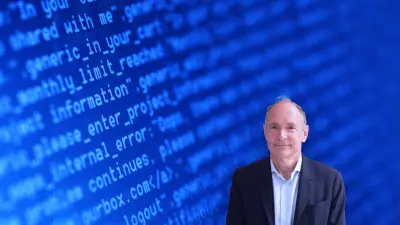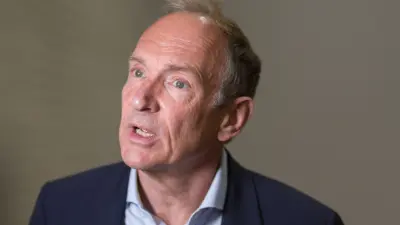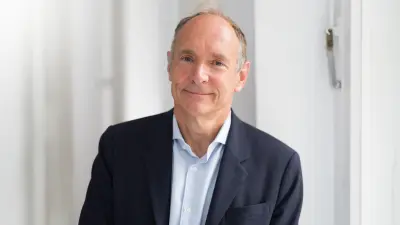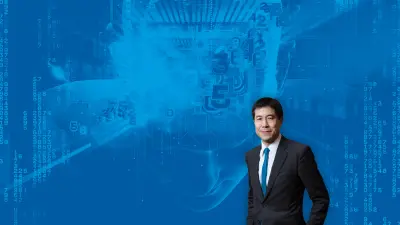The future of the Internet
Talking to the inventor of the World Wide Web

2019-09-11
Some 30 years ago, Tim Berners-Lee invented the World Wide Web. Today, he has come up with new ideas for future-proofing his baby. It certainly needs some care and attention, as he explains himself.
Can we imagine the Internet, and therefore our modern way of life, without Tim Berners-Lee? This is, of course, a rhetorical question, but the facts speak for themselves: Berners-Lee was instrumental in the birth of the World Wide Web. It was his vision at the end of the 1980s of giving scientists at CERN, the Geneva-based European Particle Physics Laboratory, a means of sharing data and findings anywhere in the world that resulted in the pioneering network that we know today as the Internet. In doing so, he created a framework for linking up billions of computers.

Berners-Lee had spotted a gap, recognized the potential — and developed a solution. As a physicist and computer scientist, he says that you know an invention is good if “it is good for people, for humanity.” And just as he wanted his invention to be his “gift” to society, he also sees the potential for improving it and for making sure that it continues to serve humanity in the future. As he explains: “We have seen that just giving people the ability to communicate with each other leads naturally to a lot of wonderful things but also it can lead to really unpleasant things.”
Using the World Wide Web to scale new heights
For Berners-Lee, an example of a potential improvement is the optimization of the way social media works and how personal data is dealt with. “People realize that their personal data is being used in a system and that this system is being used to manipulate people.” So, what is the solution? “Change and reengineer some of it. There is a lot more that we can expect from the Internet, that we can achieve, but it won’t come by itself.”
Tim Berners-Lee sees the Internet as the basis for innovation that has the potential to scale new heights. “What I’d like people to do is to build systems in which we can more or less establish a common understanding of what is true about the world. Maybe there will be something like Wikipedia for democracy, where we can go to form a common understanding democratically about what decisions that we should take.”
11 billion
connected IoT devices are around the world. (Statista 2018)
A freely accessible Internet of Things
Berners-Lee believes the Internet must be open, free and accessible to all, and that also goes for the Internet of Things (IoT). With eager anticipation, he views the progression of the Web from a network of information (Web 1.0) to a network of people (Web 2.0/Social Media) and now to a network of things (Web 3.0/IoT). “The Internet of Things is a lot about automation. So, what is clearly important is that the connected systems work well together so that no matter who you buy your Internet of Things gadgets from — whether industry or consumer — they should all work together.” The use of personal data is key here too.
„The web has become boring and constraining for a lot of people, because they spend all their time in one social network.“
The Solid platform — for a decentralized World Wide Web
In response to the latest developments and challenges, Berners-Lee has been working on the creation of the platform Solid (Social Linked Data), which was researched and implemented at the Massachusetts Institute of Technology (MIT) and Oxford University. Solid helps “to break open the silos” between individual networks, as Berners-Lee explains. The objective is for data to no longer be stored by individual companies such as Google, Amazon or social media providers, even if their software is being used. Instead, it should be stored where the user wants it to be. That way, everyone gains more control over their own data, which is stored in pods.
The settings for each pod would allow users to decide for themselves which providers, such as health apps, are allowed to access the data it contains. “It will be very powerful for the individual,” says Berners-Lee. In addition, this model would allow anyone to develop new apps, since it would be technically possible to gain access to the data – assuming permission is granted by the person who owns it. Just like with the Internet 30 years ago, Tim Berners-Lee is convinced that Solid is the digital future. And only the future will tell if his latest invention can improve on his most famous one.
An interview with Tim Berners-Lee, the inventor of the WWW

Loading the video requires your consent. If you agree by clicking on the Play icon, the video will load and data will be transmitted to Google as well as information will be accessed and stored by Google on your device. Google may be able to link these data or information with existing data.
Profile

Tim Berners-Lee, 64
CTO & Professor CSAIL/MIT
Life involves understanding in many different areas and you have to use the interrelationship between those areas to do new exciting things.
Tim Berners-Lee invented HTML (Hypertext Markup Language) and the World Wide Web in 1989 while working as a software engineer at CERN in Geneva, Switzerland. Today he is the director of the World Wide Web Consortium (W3C), as well as a professor at the Massachusetts Institute of Technology (MIT) and, since 2016, at the University of Oxford.
Summary
Tim Berners-Lee, the founder of the World Wide Web, believes his invention needs to be upgraded for the digital future, especially regarding the privacy of personal data and the power of individual networks. As Berners-Lee looks forward to the innovations that must now be developed for the future Internet, his own contribution is the Solid platform, which would give users back the control over their data.


